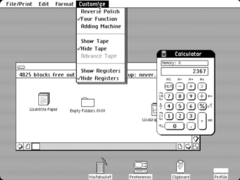 The Apple Lisa—also known as the Lisa—is a personal computer designed by Apple Computer, Inc. (now Apple, Inc.) during the early 1980s.
The Apple Lisa—also known as the Lisa—is a personal computer designed by Apple Computer, Inc. (now Apple, Inc.) during the early 1980s.Development of the Lisa began in 1978 as a powerful personal computer with a graphical user interface (GUI) targeted toward business customers.
In 1982, Steve Jobs was forced out of the Lisa project, so he joined the Macintosh project instead. The Macintosh is not a direct descendant of Lisa, although there are obvious similarities between the systems and the final revision, the Lisa 2/10, was modified and sold as the Macintosh XL.
The Lisa was a more advanced system than the Macintosh of that time in many respects, such as its inclusion of protected memory, cooperative multitasking, a generally more sophisticated hard disk based operating system, a built-in screensaver, an advanced calculator with a paper tape and RPN, support for up to two megabytes (MB) of RAM, expansion slots, a numeric keypad, data corruption protection schemes such as block sparing, non-physical file names (with the ability to have multiple documents with the same name), and a larger higher-resolution display. It would be many years before many of those features were implemented on the Macintosh platform. Protected memory, for instance, did not arrive until the Mac OS X operating system was released in 2001. The Macintosh featured a faster 68000 processor (7.89 MHz) and sound. The complexity of the Lisa operating system and its programs taxed the 5 MHz Motorola 68000 microprocessor so that consumers said it felt sluggish, particularly when scrolling in documents.
Software
The Lisa operating system featured cooperative (non-preemptive) multitasking and virtual memory, then extremely advanced features for a personal computer. The use of virtual memory coupled with a fairly slow disk system made the system performance seem glacial at times. Based in part on advanced elements from the failed Apple III SOS operating system released three years earlier, the Lisa also organized its files in hierarchal directories, making the use of large hard drives practical. The Macintosh would eventually adopt this disk organizational design as well for its HFS filing system. Conceptually, the Lisa resembles the Xerox Star in the sense that it was envisioned as an office computing system; consequently, Lisa has two main user modes: the Lisa Office System and the Workshop. The Lisa Office System is the GUI environment for end users. The Workshop was a program development environment, and was almost entirely text-based, though it used a GUI text editor. The Lisa Office System was eventually renamed "7/7", in reference to the seven supplied application programs: LisaWrite, LisaCalc, LisaDraw, LisaGraph, LisaProject, LisaList, and LisaTerminal




always make sensasi.....
ur Link alredy i ADD to my blog...Pls Add my Link.....tq
Klik Here